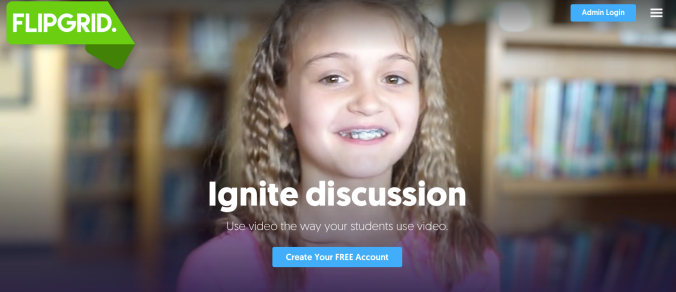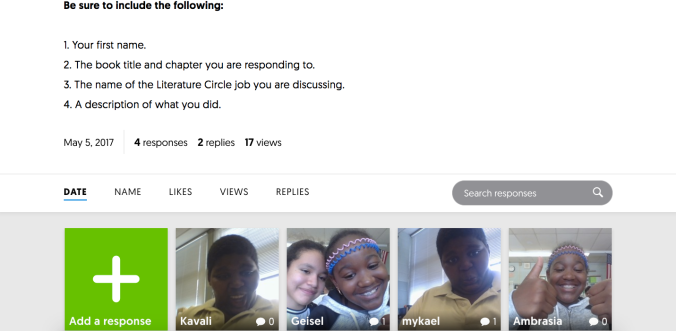
Flipgrid is a video discussion community that helps teachers amplify student voice inside (and outside) their classrooms. And it’s perfect for Literature Circles. This secure digital platform allows students to use video as a tool to respond to and connect with literature in a collaborative and secure environment.

Teachers (or their students) can create “grids” for each Literature Circle book group and easily share the links in Google Classroom or on a class website. A join code is generated by the application and can be customized for each book group.

Students can then submit video responses to chapters read and engage in virtual Literature Circle book discussions from anywhere they are, at anytime they choose. This component is especially powerful for busy middle and high school students!

Students can view each other’s videos then “like” and respond to them; all within the secure confines of the Flipgrid platform. As you can see, they absolutely LOVE it!

Teachers can monitor all student activity from the Flipgrid dashboard. Here, video responses can be assessed and feedback can be given to individual students or the entire group.

Flipgrid is an excellent tool to add to your repertoire of Literature Circle tools. I highly recommend it! In fact, it is one of the tech tools I’ll be featuring in my sold out ISTE 2017 session,
Literature Circles 2.0: Technology-Infused Book Clubs in the Digital Age
on June 27th in San Antonio, Texas.

Would you like to try Flipgrid Classroom for free this summer? If so, use the following code for an upgrade that is good until September 30:
LEEARAOZ
Click the image below to sign up for Flipgrid Classroom TODAY!
P.S. Flipgrid is also an excellent tool for collecting and sharing Genius Hour reflections.


Excellent tool for literature discussion!
LikeLiked by 1 person
My students LOVE to create video responses! It’s right up their alley.
LikeLike
Pingback: OTR Links 08/05/2017 – doug — off the record
Lee,
For reflections, like those on the Genius hour post, I love these. I’m wondering about lit circles, though. When we engage in discussions on literature in the classroom, we can help students become aware of and practice a much wider range of skills, namely those associated with interpersonal interaction. Using Flipgrid to conduct these discussions seems to me to be a mere substitution on the SAMR model, a substitution that loses the interpersonal or, if not losing it, shifting it to a simple turn-taking not necessitating the interpersonal attention of understanding when and how to move into a live discussion.
Sure, it introduces a time constraint, and we could suggest that other skills–concision of expression for example–come into play, but I’m not convinced that this use of flipgrid does much to improve lit. circles. Indeed, when you write, “This component is especially powerful for busy middle and high school students!” I’m concerned about how that impacts the lives of students. The standard, “well, kids are busy so this gives them an option to find time in their day to get this done” seems an excellent one on face, but what if all teachers adopted this? Where do we draw the line between extending student learning and intruding on the lives of human beings in ways that we are already seeing are detrimental to adults. Indeed, it introduces an extra responsibility to the task of the lit circle participant that further burdens the act of reading itself.
I understand the ability to assess student contributions, but what we know about feedback is that the more immediate it is, the more students pay attention. When I do lit circles, I’m always moving in and out of the circles, offering immediate feedback on both the content of responses and the social aspects of the circle. Additionally students are asked to self-assess on their participation as well as their group’s dynamics. These continuous reflections help students generate a narrative of growth and discuss not only the book in question but also the process/group dynamics–a key soft skill that we know is important for later success in life.
I’m not questioning flipgrid as a whole. I’ve used it in my class for several things. And certainly it does provide an option for more introverted students to engage in discussions in ways that better meet their own personalities. I’m simply questioning the use of the tool in this instance.
LikeLiked by 1 person
Pingback: Scaffolding students with Padlet and Flipgrid : Innovative Education in VT